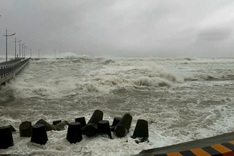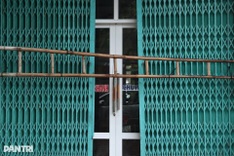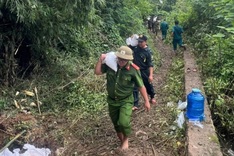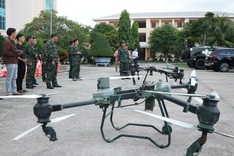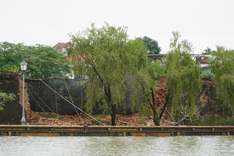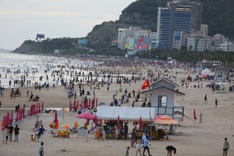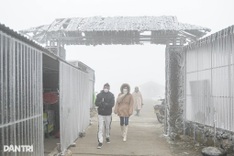In the dark-coloured mist of dust, women silently push their brick-carrying trolleys in and out.
Coming to An Ban Village (Song Ve Town, Quang Ngai Province), many will be surprised at the sight of dozens of brick kilns, masses of smoke clouding the sky reminiscent of what one would expect from a large industrial park in operation.
The winding road leading to the village, due to the thousands of trucks carrying loads of brick, clay, and furnace materials in and out every day, is extremely uneven on the surface. The smell of CO2 produced from the brick kilns here is enough to make a person gag the first time they enter the village.
Houses are fully covered with canvas to stop the dust from getting inside, the bamboo hedges are coated with a layer of white that resembles the ashes of death under the sunshine. Some naive youngsters play beside loads of brick on the streets and this site is seen on every corner of the village.
Just taking a stroll around the village once, a person's face becomes covered with a grayish layer of dust, and combined with sweat, it becomes a wax-like substance that could be peeled if allowed to dry. The local people in this village have had to live in this air-polluted environment for generations.
| CO2 emissions from coal, if inhaled frequently, can cause a series of diseases such as respiratory disease, cardiovascular disease, throat inflammation, chest pain, breathing difficulty, and lung cancer. |
Most brickmakers here were found to be women. They are extremely quick and skillful in what they do and if you didn't know, one would not assume they are female. From kneading the clay, putting it in the mould, stacking the bricks in the drying area to heating them and removing them from the kiln, the whole cycle repeats over and over again just like their painstaking life.
Vo Thi Be, a 35 year old woman, from Nghia Hiep Commune (Tu Nghia District) said, "Whenever the farming season is over, I cycle a few kilometres to come here and do brickmaking work. Each day I can earn VND 40,000 (USD 2) for over 8 hours of work. I'm doing this for my children, so that they can have enough food to eat."
Pham Thi Nhu, a 75 year-old elder living in the village shared with us that she is still making bricks despite her old age, and that her husband is also a brickmaker. Because neither of them had any land to grow crops, they had no choice but to choose this hard job as a means for their living. "I have been doing this since I was a young girl, I'm so glad that now the roads in the village have been asphalted, thus making it less dirty and polluted during the dry season. The men in this village often head down south to become a mason, or do other kind of work. They almost never stay to do brickmaking, and it has become a tradition in this village to have women working as brickmakers," Nhu added.

Billows of smoke consume the whole village.

To avoid dust, these woman brickmakers always have to wear a fully-covered mask.

From kneading the clay to carrying the bricks, they do it in a quick and skillful manner.
Woman brickmakers hard at work.


